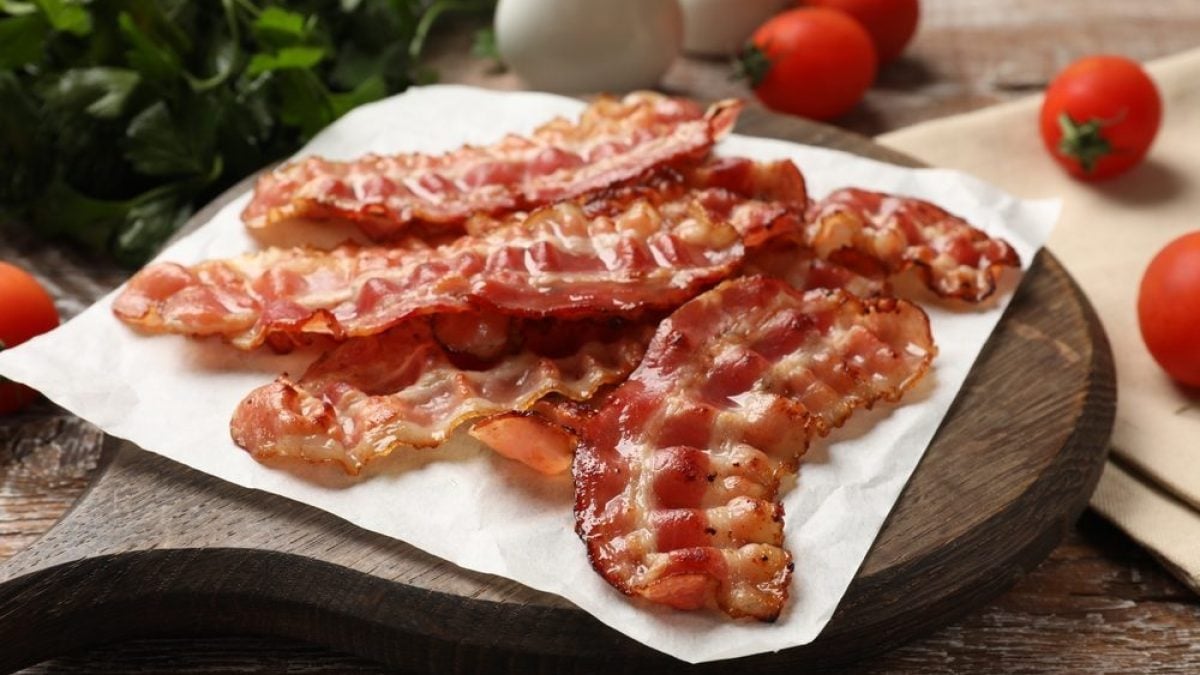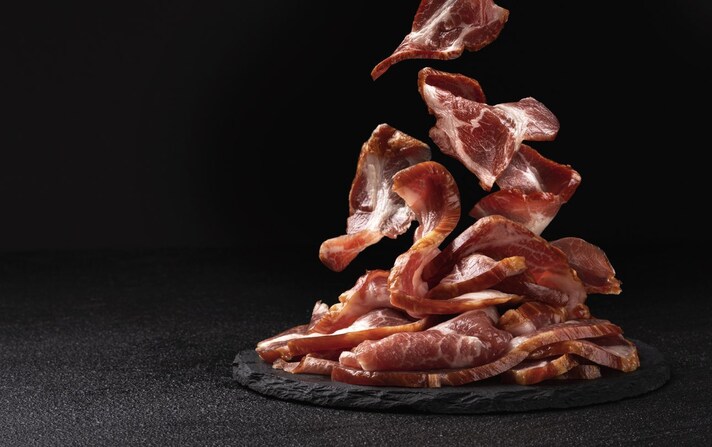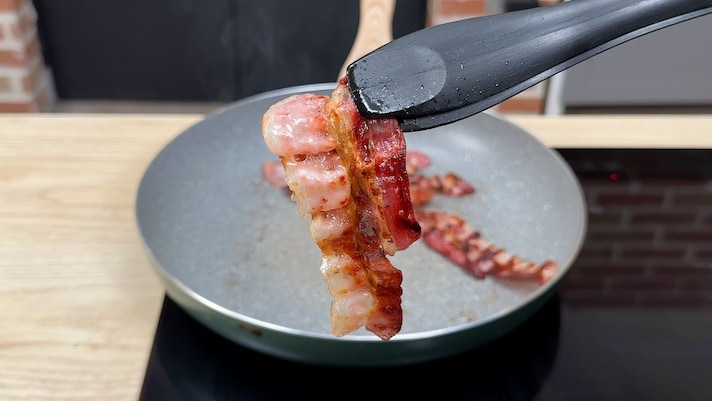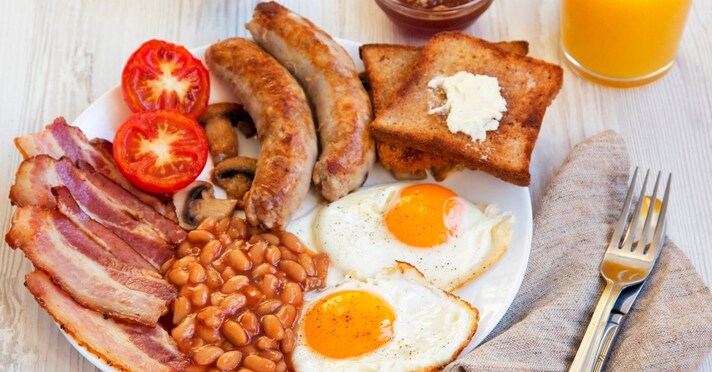
A symbol of American culture around the world, but actually a traditional product in all English-speaking countries like the United Kingdom, Ireland, and Canada, bacon is more than just a cured meat, but a true icon of Anglo-Saxon and, consequently, American cuisine. It's usually associated with traditional recipes like the classic breakfast paired with eggs, or as an essential ingredient in the legendary American cheeseburgers, but it's a more multifaceted product than you imagine. We often use bacon as a synonym for pancetta, but that's actually a mistake: bacon is a product in its own right, obtained from different parts of the pig than Italian pancetta, processed differently, and available on the market in many varieties. Let's embark on a journey to discover bacon, exploring its origins—which are older than you might imagine—the specifics of its processing, and the best way to enjoy it.

How is Bacon Made and What Kind of Meat Does It Contain?
Bacon is a cured pork product typical of the culinary traditions of Anglo-Saxon countries, including the United Kingdom and Ireland, and those with similar cultural roots, such as the United States and Canada. The term derives from the Middle English "bacoun," which in turn likely harks back to the Proto-Germanic word "bacho," meaning "pig's hindquarters," which in itself explains the type of raw material used to make this specialty.
Bacon is obtained from various parts of the pig, unlike pancetta, which is exclusively obtained from the belly. Bacon can come from the belly, loin, chuck, or flank and is intended to be eaten exclusively cooked. Even the pancetta that most closely resembles it, the "stretched" type, is also meant to be eaten raw because it undergoes a curing process that bacon does not undergo (it is instead left to marinate). We're used to seeing it all as the same, but in reality, there are many types obtained using different processing techniques.

"Generic" bacon, the most common kind, the one you can easily find at the supermarket, is first dry-salted or (even more likely) pickled with pepper and other spices, then dried for a few days and in some cases even smoked. Cooked bacon can be eaten as is; raw bacon should always be cooked, especially if it's only been pickled. This is the most common type of bacon, the one typically used for those famous sandwiches and the celebrated English breakfast, but it's not the only type out there. They are very widespread in the American and English world, where each country has a particular type that is consumed most:
- Side bacon is made from pork belly and is characterized by long layers of fat running parallel to the rind. It's the most popular type of bacon in the United States, eaten for breakfast with eggs or savory pancakes, and the most beloved by Americans, who consume approximately 1 billion pounds of it each year.
- Middle bacon comes from the flanks of the pig, is of lower quality and has a less strong flavor, which is why it is less used.
- Black bacon is the British variety, particularly popular in the United Kingdom, Ireland, and Eastern Canada (it's no coincidence that it's also called Irish bacon or Canadian bacon, although this latter term is only used in the United States). It's a very lean and meaty cut taken from the loin at the center of the animal's back and has a texture and flavor more similar to Italian prosciutto crudo.
- Jowl bacon is the equivalent of our guanciale. Made from pig cheeks, it's usually smoked and has a rich, intense flavor.
- Cottage bacon is lean, thinly sliced, and comes from the shoulder. It's usually oval, not rectangular like other types. This type is left to cure longer and is typically used for frying.
- More niche types of bacon are derived from other various cuts of pork, for example slab bacon, which has the highest percentage of fat and is obtained from the belly, side cuts and back, collar bacon obtained from the neck of the pig, hock bacon extracted from a small ankle joint and gammon bacon, obtained from the hind leg.

There's a certain amount of mistrust surrounding bacon because it's often accused of being an industrial product full of additives. The truth is a bit different: as with cured meats, it always depends on who produces it. Just like hams, salamis, and pancetta, bacon can be artisanal or industrial; it's obvious that commercial bacon, especially produced in the United States, could be less healthy, especially since we know that many additives prohibited in other countries are permitted here. The quality of bacon, therefore, isn't good or bad in isolation: it depends on the producer, the type of processing, and the quality of the raw material.
A Cured Meat Already Known in 1500 BC
Bacon is automatically associated with the United States of America, and for this reason it's assumed to be a fairly modern product. Nothing could be further from the truth: first of all, bacon originates from Great Britain and was most likely imported to the United States by the English colonists who founded the new nation. But the British themselves imported bacon even further back in time: according to some research, in fact, it appears that a very similar product was already being consumed in 1500 BC in the British colonies of the Roman Empire. Furthermore, other studies claim that the true origins of bacon actually lie in ancient China, since even earlier (around 3,000 BC) the Chinese used to process and cure pork in a way that was very similar to what would later become bacon.
It's possible that the Romans, through various trade exchanges, learned about the curing process and began producing the same product, later bringing it to their colonies and then to Great Britain, where it became a widespread preparation. Until the 17th century, in fact, the term "pancetta" referred to any type of pork cut processed like today's bacon. Only from this era onward did this name begin to be associated with the salted and smoked pork belly we know and love today.

It is at this point that the two specialties diverge: here, pancetta remains, while in Great Britain (and in all the countries that will be conquered or come into contact with this culture) bacon becomes the norm. Before industrialization, its preparation was a completely artisanal process, carried out by hand, while from the 18th century onwards, it was industrialized: the first bacon factory was inaugurated precisely during this period, opened by John Harris in Wiltshire.
What's The Perfect Way to Cook Bacon?
Bacon can be cooked in a variety of ways, including in the oven or microwave, but if you want to cook it truly English or American-style, there's only one way to do it: pan-frying, which is ideal for making it crispy and perfectly cooked. Crispiness, in fact, is the key to bacon being truly cooked to perfection and ready to be tossed into eggs or stuffed into a well-stuffed cheeseburger.
How do you get bacon slices so crispy they crunch when you chew them? First, remember to take the bacon slices out of the refrigerator for 5 minutes before cooking them, because the texture improves as the meat adjusts to room temperature. Then, place a few slices at a time on a cold nonstick pan (the result is better if the meat heats up with the pan). Be careful to leave space between the slices, which should not overlap and should not have folded edges.

Turn the heat to medium and let it sizzle without adding anything else, as the bacon releases its fat, which will grease the pan nicely. When the slices begin to brown and wrinkle, flip them over with kitchen tongs and remove them from the pan when they are a nice dark color. At this point, let them rest on a plate lined with paper towels to absorb the excess fat, and then they are ready to be used: if you want to stick to tradition, use them with scrambled eggs or add them to the rest of the classic English breakfast, to iconic pancakes, or in rich sandwiches. Alternatively, you can adapt them to more local recipes, for example, crumbling them as a crunchy addition to a creamy pasta dish or to wrap morsels of meat and create succulent parcels.

;Resize,width=767;)
